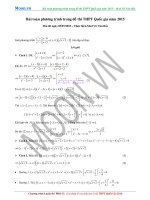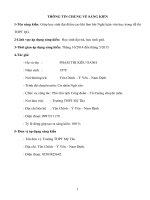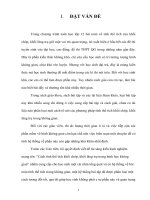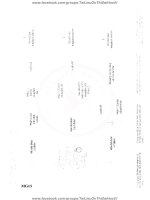DE THPT QG
Bạn đang xem bản rút gọn của tài liệu. Xem và tải ngay bản đầy đủ của tài liệu tại đây (63.21 KB, 6 trang )
<span class='text_page_counter'>(1)</span>MR. BEAN’S MATERIALS (Đề thi gồm: 06 trang). ĐỀ KTCL ÔN THI THPT QUỐC GIA NĂM 2016 Môn: TIẾNG ANH Thời gian làm bài: 90 phút, không kể thời gian phát đề. PHẦN TRẮC NGHIỆM: (8 điểm) Mark the letter A, B, C, or D on your answer sheet to indicate the word whose underlined part differs from the other three in pronunciation in each of the following questions. Question 1. A. transfer B. career C. variety D. afraid Question 2. A. surfaces B. temples C. exercises D. pages Mark the letter A, B, C or D on your answer sheet to indicate the word that differs from the other three in the position of primary stress in each of the following questions. Question 3. A. powerful B. remember C. obvious D. primary Question 4. A. sacrifice B. impossible C. confident D. interview Question 5. A. vacant B. factor C. college D. device Mark the letter A, B, C or D on your answer sheet to indicate the word(s) CLOSEST in meaning to the underlined word(s) in each of the following questions. Question 6. In the 1980s, TV viewers began to hook up videocassette players to their TVs. A. combine B. stop C. fasten D. connect Question 7. Thanks to better health care, there are more and more centenarians nowadays. A. children whose parents can't afford their schooling B. children who die at birth C. people who live 100 years or more D. people who suffer from fatal diseases Question 8. These machines are older models and have to be operated by hand. A. manually B. spiritually C. automatically D. mechanically Mark the letter A, B, C, or D on your answer sheet to indicate the word or phrase that is OPPOSITE in meaning to the underlined part in each of the following questions. Question 9: They have not made any effort to integrate with the local community. A. cooperate B. induce C. separate D. depreciate Question 10. This kind of dress is outmoded so you shouldn’t dress it up at the party. A. unfashionable B. incompetent C. fashionable D. unattractive Mark the letter A, B, C, or D on your answer sheet to show the underlined part that needs correction. Question 11. An increasing number of companies has changed dress codes, allowing employees to wear casual clothing in the workjng place. A. in the working place B. has changed C. increasing D. to wear Question 12. Among the earliest telescopes were Galilean telescopes, modeled after the simple instruments built by Galileo, the first person having used telescopes to study the stars and planets A. having used B. telescopes C. modeled D. were Question 13. Mr. Lam insisted that we show our best knowledge, our enthusiasm, our keen on work and our sense of responsibility when working in a team. A. when working B. show C. sense of D. keen on Question 14. Victims of carpal tunnel syndrome include electricians drilling holes for wiring, airline workers to type at chest- high terminals, and check- out clerks lifting and twisting groceries to register prices on the scanner. A. include B. for wiring C. to type D. to register prices Question 15. First designed in 1970, Earth Day has become an international event that dedicate to raising concerns about environmental issues such as pollution. A. as pollution B. raising concerns C. First designed D. that dedicates.
<span class='text_page_counter'>(2)</span> Mark the letter A, B, C or D on your answer sheet to indicate the correct answer to each of the following questions. Question 16. Her boss fired her, __________ made her angry. A. that B. this C. what D. which Question 17. You__________ the washing. My sister could have done it for you. A. needn't have done B. couldn't have done C. hadn't to do D. mustn't have done Question 18. These school-leavers are looking forward__________ on campus. A. living B. to live C. live D. to living Question 19. Would you like to take a gap year before__________ a university? A. filling in B. applying to C. applying for D. filling out Question 20. In 1837 the University of Michigan became the first state university__________ by a board of regents elected by the voters of the state. A. being controlled B. it was controlled C. to be controlled D. under the control Question 21. We all believe that a happy marriage should be__________ mutual love. A. based on B. concerned with C. confided in D. obliged to Question 22. By the end of the 21st century, the first car running on the sea water__________. A. will finish B. will be finished C. will have been finished D. will be finishing Question 23. - "What a lovely house you have!" - "_______________" A. No problem. B. Thank you. Hope you will drop in. C. Of course not, it's not costly. D. I think so. Question 24. __________ I get your letter, I will reply to you at once. A. By the time B. As though C. As soon as D. Now that Question 25. __________ not to come late, the applicant set out for his job interview. A. He was advised B. People advised him C. Advised D. Advising Question 26. If Lucy's car__________ down, she would be here right now. A. wouldn't have been B. hadn't broken C. doesn't break D. didn't break Question 27. __________ the film director, Ben Affleck, was famously left off of the 85 th Oscar's Best Director list of nominees surprised everyone. A. Although B. What C. Due to D. That Question 28. According to__________ people, most animal and plant species on earth will soon die out. A. optimists B. pessimistic C. pessimists D. optimistic Question 29. My mother asked me__________. A. which tertiary institution did I choose B. which tertiary institution I choose C. which tertiary institution I would choose D. which tertiary institution will I choose Question 30. It is really an__________ . A. undergraduate interesting economics course B. economics course interesting undergraduate C. interesting economics undergraduate course D. interesting undergraduate economics course Question 31. Not until__________ in my paper__________ to write down my name on it. A. I handed/ that I remembered B. I handed/ did I remember C. did I hand/ did I remember D. did I hand/ I remembered Question 32. - ''Did you enjoy the movie yesterday?" - "_______________ " A. Certainly, I'd be glad to. B. Yes, it is warmer than today. C. Not really. I couldn't follow the story. D. No, I dislike moving. Question 33. Is it necessary that I__________ here tomorrow? A. would be B. am being C. were D. be Question 34. We received a call from the teacher__________ charge of our course. A. on B. at C. in D. to Read the following passage and mark the letter A, B, C, or D on your answer sheet to indicate the correct answer to each of the following questions..
<span class='text_page_counter'>(3)</span> A survey is a study, generally in the form of an interview or a questionnaire, which provides information concerning how people think and act. In the United States, the best-known surveys are the Gallup poll and the Harris poll. As anyone who watches the news during presidential campaigns knows, these polls have become an important part of political life in the United States. North Americans are familiar with the many "person on the street" interviews on local television news shows. While such interviews can be highly entertaining, they are not necessarily an accurate indication of public opinion. First, they reflect the opinions of only those people who appear at a certain location. Thus, such samples can be biased in favor of commuters, middle-class shoppers, or factory workers, depending on which area the new people select. Second, television interviews tend to attract outgoing people who are willing to appear on the air, while they frighten away others who may feel intimidated by a camera. A survey must be based on a precise, representative sampling if it is to genuinely reflect a broad range of the population. In preparing to conduct a survey, sociologists must exercise great care in the wording of questions. An effective survey question must be simple and clear enough for people to understand it. It must also be specific enough so that there are no problems in interpreting the results. Even questions that are less structured must be carefully phrased in order to elicit the type of information desired. Surveys can be indispensable sources of information, but only if the sampling is done properly and the questions are worded accurately. There are two main forms of surveys: the interview and the questionnaire. Each of these forms of survey research has its advantages. An interviewer can obtain a high response rate because people find it more difficult to turn down a personal request for an interview than to throw away a written questionnaire. In addition, an interviewer can go beyond written questions and probe for a subject's underlying feelings and reasons. However, questionnaires have the advantage of being cheaper and more consistent. Question 35. According to the passage, the main disadvantage of person-on-the-street interviews is that they__________. A. are not based on a representative sampling B. reflect political opinions C. are not carefully worded D. are used only on television Question 36. According to the passage, one advantage of live interviews over questionnaires is that live interviews__________. A. minimize the influence of the researcher B. are easier to interpret C. costless D. can produce more information Question 37. The word "precise" is closest in meaning to__________. A. accurate B. rational C. required D. planned Question 38. According to the reading passage, there are ____ main categories of surveys. A. four B. five C. two D. three Question 39. Which word is given definition in the text? A. sampling B. poll C. survey D. interview Question 40. The word "they" refers to___________. A. interviews B. opinions C. news shows D. North Americans Question 41. What does the passage mainly discuss? A. The principles of conducting surveys B. The importance of polls in American political life C. Problems associated with interpreting surveys D. The history of surveys in North America Question 42. According to paragraph 3, which of the following is most important for an effective survey? A. A sociologist who is able to interpret the results B. Carefully worded questions C. An interviewer's ability to measure respondents' feelings D. A high number of respondents.
<span class='text_page_counter'>(4)</span> Question 43. The word "indispensable" is closest in meaning to__________. A. necessary B. complicated C. expensive D. simple Question 44. It can be inferred from the passage that one reason that sociologists may become frustrated with questionnaires is that__________. A. respondents often do not complete and return questionnaires B. questionnaires are expensive and difficult to distribute C. respondents are too eager to supplement questions with their own opinions D. questionnaires are often difficult to read Read the following passage and mark on your answer sheet to indicate the correct word for each of the blanks. Feminism, collective term for systems of belief and theories that pay special (45)_________ to women’s rights and women’s position in culture and society. The term tends to be used for the women’s rights movement, which began in the late 18th century and continues to campaign for complete political, social, and economic equality between women and men. This article (46)_________ specifically with the development of the ideas behind that movement and their (47)_________ and impact. Feminists are united by the idea that women’s position in society is unequal to (48)_________ of men, and that society is structured in such a way as to benefit men to the political, social, and economic (45)_________ of women. However, feminists have used different theories to explain these (50)_________ and have advocated different ways of redressing inequalities, and there are marked geographic and historical variations in the nature of feminism. Historically, feminist thought and activity can be divided into two waves. The first wave, which began in about 1800 and (51)_________ until the 1930s, was largely concerned with gaining equal rights between women and men. The second wave, which began in the late 1960s, has continued to fight for (52)_________ but has also developed a (53)_________ of theories and approaches that stress the difference between women and men and that draw attention to the (54)_________ needs of women. Question 45. A. notice Question 46. A. deals Question 47. A. pressure Question 48. A. most Question 49. A. detriment Question 50. A. difference Question 51. A. widened Question 52. A. freedom Question 53. A. kind Question 54. A. definite. B. attention B. provide B. problem B. those B. deviance B. unequalities B. spent B. independence B. sort B. specific. C. benefit C. familiar C. variation C. that C. dismalness C. equalities C. lasted C. tradition C. range C. vague. D. equality D. initiates D. influence D. which D. diffusion D. inequalities D. lengthened D. equality D. type D. general. Read the following passage and mark the letter A, B, C, or D on your answer sheet to indicate the correct answer. Before photography was invented in 1839, painted portraits, and engravings based on them, were one of the few ways to record likenesses. From the Colonial era through the 1820s, portraiture was the most widely practiced genre of American art, and it continued to be a significant form through the 19th century. The demand for likenesses was incessant, and portraiture was often the primary source of income for artists. Artists frequently made portraits of famous people to attract interest and potential patrons. For example, in 1834 Chester Harding painted frontiersman Davy Crockett, then a member of the U.S. House of Representatives, for display in his Boston gallery. A consistent belief through most of the 18th and 19th centuries was that character could be read from a person's face, or the bumps on his or her head, or from facial expressions, and that portraits should convey these indicators of character. These theories of physiognomy and phrenology have since been debunked, but they were important considerations in depicting the nation's leaders,.
<span class='text_page_counter'>(5)</span> since such portraits were often made for posterity. Most people had only one portrait painted in their lifetime, if at all, so artists were selected with great care, and expectations were high. Before the 1840s, American portraiture was influenced primarily by English techniques, poses, compositions and gestures, and many artists received at least part of their training in England. Even canvas sizes followed the British example. Portraits made on commission were priced according to canvas size and the materials and labor involved. In the late 19th century as European portraitists began traveling to the United States to acquire commissions from the growing upper class, American artists increasingly felt they needed to train abroad in order to succeed at home. Paris continued to be the main lure. as painters such as Eakins, Whistler, Beaux and Sargent went to study there. Some of America's best-known portraitists, in fact, became expatriates. Question 55. What does the passage mainly discussed? A. art in 19th century America B. portraiture in 19th century America C. the early years of photography D. the influence of other countries on American art Question 56. Which of the following statements best represents the meaning of the first sentence (lines1 and 2) before photography was invented in 1839? A. painted portraits and engravings were very lifelike. B. there was no accurate way to record a likeness before photography was invented. C. there were not many ways other than painted portraits and engravings if you wanted to record what somebody looked like. D. engravings were based on portraits and not as lifelike Question 57. Why does the author mention Davy Crockett in paragraph 1? A. as an example of an artist using a famous person to gain attention to his work B. because Crocket was also a famous artist C. as an example of the types of people who could afford to pay for their portrait to be painted D. because gallery owners often had famous people as patrons Question 58. In paragraph 2, what did people look for in a good portrait? A. clear facial expressions B. an accurate likeness C. indicators of character D. every detail, including bumps on the head Question 59. Physiognomy and phrenology are theories__________. A. that are no longer as popular B. that were used to enable people to select artists with the best characteristics in their appearance C. that meant people usually only needed one portrait D. that were used to try to get the closet likeness possible Question 60. Where in the passage does the author draw a comparison of American and English practices in producing commission portraits? A. the first paragraph B. the second paragraph C. the third paragraph D. the fourth paragraph Question 61. The word poses is closest in meaning to__________. A. stance B. height C. weight D. manner Question 62. The word acquire is closest in meaning to__________. A. steal B. borrow C. ask D. get Question 63. In what ways did American artists try to gain greater success? A. by inviting European artists to America B. by traveling abroad C. by becoming expatriates D. by not only painting portraits Question 64. The final paragraph of the passage will probably continue with a discussion of__________. A. artists moving between countries B. other ways artists tried to gain local C. artists from other countries D. other lesser known artists.
<span class='text_page_counter'>(6)</span> PHẦN TỰ LUẬN (2 điểm) I. Finish each of the following sentences in such a way that it means the same as the sentence printed before it. Write your answers on your answer sheet. Question 1. The book is so interesting that it has become the best-seller of this year. → It is __________________________________________________________________________. Question 2. People think that he is an excellent football player. → He ___________________________________________________________________________. Question 3. My mother started cooking for the party two hours ago. → My mother has _____________________________________________________________. Question 4. In spite of the bad weather, they had a wonderful holiday. → Although ____________________________________________________________________. Question 5. “I’m sorry I gave you the wrong number” said Paula to Susan. → Paula apologized____________________________________________________________. II. Paragraph writing: With around 140 words, write a paragraph to talk about the changes in the way we travel thanks to the development of airlines industry. The following suggestions may help you: - How convenient the traveling by air is? - How safe the traveling by air is? - How fast the traveling by air is? ---------THE END--------.
<span class='text_page_counter'>(7)</span>









